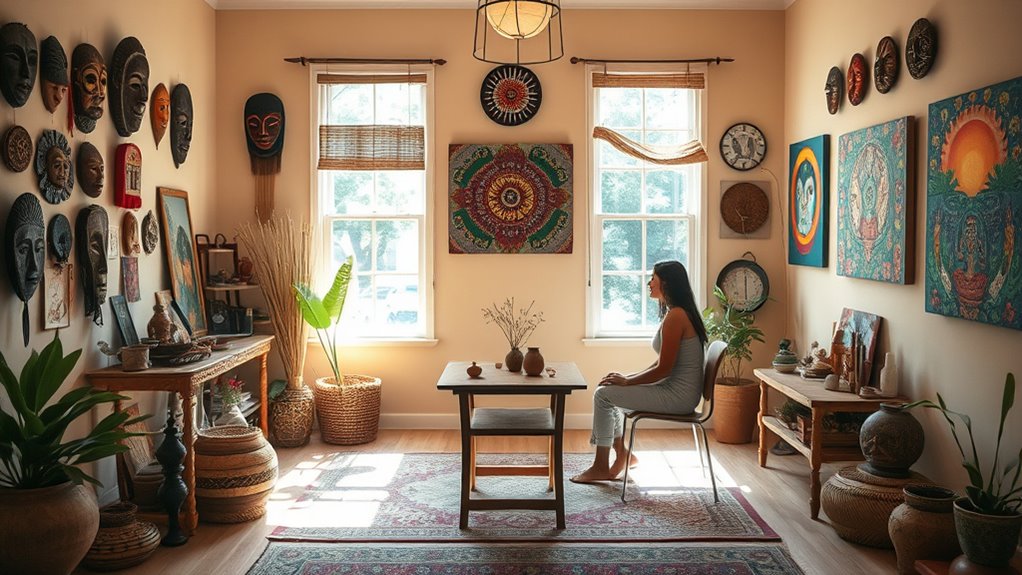To practice cultural sensitivity in art therapy, you need to respect and understand your clients’ diverse backgrounds. Avoid cultural appropriation by learning the meaning behind symbols, practices, and materials they use. Ask open-ended questions and let clients lead their creative process, ensuring their cultural identity is honored. Stay aware of your biases and seek resources when unsure. By fostering a respectful environment, you build trust and deepen the therapeutic connection—exploring these strategies helps you become more effective.
Key Takeaways
- Educate yourself about clients’ cultural backgrounds to avoid misinterpretation of symbols and motifs.
- Use open-ended questions to understand the personal meaning of cultural elements in clients’ artwork.
- Respect sacred symbols and practices, ensuring they are not used casually or out of context.
- Incorporate culturally relevant art forms and materials to promote authenticity and client engagement.
- Maintain self-awareness of personal biases and seek cultural consultation when necessary to ensure respectful practice.

Cultural sensitivity is essential in art therapy because it guarantees that practitioners respect and understand the diverse backgrounds of their clients. When working across different cultures, it’s crucial to recognize the fine line between cultural appreciation and cultural appropriation. You must be mindful not to adopt symbols, clothing, or practices from a culture that isn’t your own without understanding their significance. Engaging in cultural appropriation unintentionally can cause clients to feel misunderstood or disrespected, undermining the trust vital to therapy. Instead, focus on fostering authentic cross-cultural communication, where you actively listen and learn from your clients’ perspectives. This approach helps ensure that your interventions are respectful and meaningful, rather than superficial or dismissive.
In practice, this means educating yourself about your client’s cultural background before introducing art materials or themes. For example, if your client comes from a culture with specific sacred symbols, avoid using those symbols casually or out of context. Such actions can be hurtful or offensive, even if they’re well-intentioned. Instead, ask open-ended questions that invite clients to share what certain symbols or motifs mean to them. This not only deepens your understanding but also demonstrates respect for their cultural identity. Cross-cultural communication is a two-way process; you need to be attentive to your client’s responses and adapt your approach accordingly. This might involve using culturally relevant art forms or allowing clients to lead the creative process, ensuring their cultural expressions are honored and authentic.
Additionally, understanding the importance of cybersecurity vulnerabilities in digital art therapy tools can help protect clients’ sensitive information and uphold ethical standards. It’s also important to recognize your own biases and assumptions. Cultural sensitivity doesn’t mean you need to be an expert in every culture, but it does require humility and a willingness to learn. When in doubt, consult cultural resources or specialists, and always prioritize your client’s comfort and preferences. Respecting cultural differences in art therapy isn’t just about avoiding missteps; it’s about creating a safe space where clients can explore their identities through art without fear of judgment or cultural insensitivity. By practicing active cross-cultural communication and being cautious about cultural appropriation, you foster an environment of trust and respect. In doing so, you empower your clients to use art as a genuine reflection of their cultural identity, ultimately enhancing the therapeutic process and promoting healing.
Frequently Asked Questions
How Do Art Therapists Address Language Barriers With Diverse Clients?
You address language barriers by relying on non-verbal communication, such as art-making, gestures, and facial expressions, to facilitate understanding. You practice cultural humility, recognizing your limitations and being open to learning from your clients’ cultural backgrounds. This approach helps build trust and ensures clients feel respected and understood, even if language differences exist. By adapting your methods, you create a safe space for meaningful expression and healing.
What Training Is Recommended for Handling Cultural Misunderstandings?
You should pursue training in cross-cultural communication and cultural humility. These programs help you recognize your biases, understand diverse cultural perspectives, and respond appropriately to misunderstandings. Engaging in workshops, seminars, or courses focused on these areas equips you with practical skills to navigate cultural differences effectively. By embracing cultural humility, you demonstrate respect and openness, fostering trust and ensuring your clients feel understood and valued during therapy sessions.
How Can Art Therapy Practices Be Adapted for Different Cultural Beliefs?
Studies show that 85% of clients respond better when therapies are culturally adapted. You can adapt art therapy practices by respecting clients’ cultural beliefs and incorporating their traditional artistic expressions. Use culturally relevant materials and symbols, and encourage clients to share their personal stories through their art. This approach fosters trust and understanding, making therapy more effective and meaningful for diverse cultural backgrounds.
What Are Common Cultural Taboos to Avoid in Art Therapy Sessions?
You should avoid reinforcing cultural stereotypes and using traditional art symbols inappropriately, as they might offend or alienate clients. Be mindful of sensitive topics, religious symbols, and personal beliefs, and always seek permission before incorporating culturally significant elements. Respect individual differences, and stay open to learning about your client’s cultural background to guarantee your sessions remain respectful and inclusive.
How Do Therapists Ensure Cultural Competence Without Stereotyping?
You guarantee cultural competence by practicing cultural humility and maintaining ethnic awareness, which means staying open-minded and willing to learn from your clients’ unique backgrounds. You avoid stereotyping by asking respectful questions and listening actively to their stories. Continually educate yourself about different cultures, recognize your biases, and adapt your approach accordingly. This way, you create a safe, inclusive space where clients feel understood and respected without assumptions.
Conclusion
By embracing cultural sensitivity in your art therapy practice, you show respect and understanding for your clients’ backgrounds. It’s essential to recognize that one size doesn’t fit all, and adapting your approach can make a world of difference. Keep an open mind and be willing to learn from your clients’ unique perspectives. Remember, when you walk in someone else’s shoes, you truly see the full picture—don’t miss out on that valuable insight.









